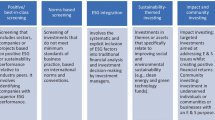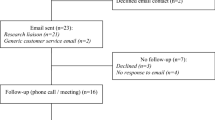Abstract
Purpose of Review
There is a critical need for corporations to be part of the solutions to major societal issues, such as obesity. Investment decisions can have a substantial impact on both corporate practices and population health. This paper aimed to explore potential mechanisms for incorporating obesity and related nutrition considerations into responsible investment (RI) approaches.
Recent Findings
We found that there are a number of available strategies for the investment community to incorporate obesity considerations into their decisions. However, despite some recent efforts to improve company disclosure in the area and the emergence of new tools for assessing food company nutrition policies, the inclusion of obesity and related nutrition considerations as part of RI is currently extremely limited.
Summary
There appears to be substantial scope to apply approaches already in widespread use for other RI considerations to the area of obesity. Ways in which to apply measurement frameworks across different markets and sectors need to be explored.
Similar content being viewed by others
References
Papers of particular interest, published recently, have been highlighted as: • Of importance •• Of major Importance
World Health Organization. Global action plan for the prevention and control of non-communicable diseases 2013-2020. Geneva: WHO; 2013. [cited March 2018]. Available from: http://apps.who.int/iris/bitstream/10665/94384/1/9789241506236_eng.pdf?ua=1&ua=1.
World Health Organization. Global status report on noncommunicable diseases 2010. Geneva: WHO; 2011. [cited April 2018]. Available from: http://apps.who.int/iris/bitstream/handle/10665/44579/9789240686458_eng.pdf;jsessionid=A2509EA9F14FC4ED0CCA21E1CE003A24?sequence=1.
Swinburn B, Sacks G, Vandevijvere S, Kumanyika S, Lobstein T, Neal B, et al. INFORMAS (International Network for Food and Obesity/non-communicable diseases Research, Monitoring and Action Support): overview and key principles. Obes Rev. 2013(S1):1.
• Swinburn B, Kraak V, Rutter H, Vandevijvere S, Lobstein T, Sacks G, et al. Strengthening of accountability systems to create healthy food environments and reduce global obesity. Lancet. 2015;385(9986):2534–45. Outlines mechanism to increase accountability for obesity prevention across a range of sectors.
Mialon M, Swinburn B, Sacks G. A proposed approach to systematically identify and monitor the corporate political activity of the food industry with respect to public health using publicly available information. Obes Rev. 2015;16(7):519–30.
Kunkel DL, Castonguay JS, Filer CR. Evaluating industry self-regulation of food marketing to children. Am J Prev Med. 2015;49(2):181–7.
Magnusson R, Reeve B. Food reformulation, responsive regulation, and “regulatory scaffolding”: strengthening performance of salt reduction programs in Australia and the United Kingdom. Nutrients. 2015;7(7):5281–308.
Ronit K, Jensen JD. Obesity and industry self-regulation of food and beverage marketing: a literature review. Eur J Clin Nutr. 2014;68(7):753–9.
Jones A, Magnusson R, Swinburn B, Webster J, Wood A, Sacks G, et al. Designing a healthy food partnership: lessons from the Australian food and health dialogue. BMC Public Health. 2016;16(1):651.
Sacks G, Robinson E, for INFORMAS. Inside our food and beverage manufacturers: assessment of company policies and commitments related to obesity prevention and nutrition. Melbourne: Deakin University; 2018. [cited May 2018]. Available from: https://www.insideourfoodcompanies.com.au/foodandbev.
Knai C, Petticrew M, Durand MA, Eastmure E, James L, Mehrotra A, et al. Has a public–private partnership resulted in action on healthier diets in England? An analysis of the public health responsibility deal food pledges. Food Policy. 2015;54:1–10.
• European Sustainable and Responsible Investment Forum (Eurosif). European SRI study 2016. Brussels: Eurosif; 2016. Prominent industry report outlining key responsible investment trends in Europe.
Ito Y, Managi S, Matsuda A. Performances of socially responsible investment and environmentally friendly funds. J Oper Res Soc. 2013;64(11):1583–94.
Pérez-Gladish B, Rodríguez PM, M'Zali B, Lang P. Mutual funds efficiency measurement under financial and social responsibility criteria. J Multi-Criteria Decis Anal. 2013;20(3–4):109–25.
• Global Sustainable Investment Alliance. Global sustainable investment review 2016. [cited February 2018]. Available from: http://www.gsi-alliance.org/wp-content/uploads/2017/03/GSIR_Review2016.F.pdf. Prominent industry report outlining key responsible investment trends in major markets globally.
The Forum for Sustainble and Responsible Investment (US SIF). The impact of sustainable and responsible investment. Washington: US SIF; 2016.
Sparkes R, Cowton CJ. The maturing of socially responsible investment: a review of the developing link with corporate social responsibility. J Bus Ethics. 2004;52(1):45–57.
The Forum for Sustainable and Responsible Investment (US SIF). Report on US sustainable, responsible and impact investing trends 2016. Executive summary. Washington: US SIF; 2016.
RobecoSAM. Sustainability assessment: corporate sustainability 2018. [cited May 2018]. Available from: http://www.sustainability-indices.com/sustainability-assessment/corporate-sustainability.jsp.
Wagemans FAJ, van Koppen CSA, Mol APJ. The effectiveness of socially responsible investment: a review. J Integr Environ Sci. 2013;10(3–4):235–52.
Arjaliès D-L. A social movement perspective on finance: how socially responsible investment mattered. J Bus Ethics. 2010;92(1):57–78.
Guay T, Doh JP, Sinclair G. Non-governmental organizations, shareholder activism, and socially responsible investments: ethical, strategic, and governance implications. J Bus Ethics. 2004;52(1):125–39.
Renneboog L, Ter Horst J, Zhang C. Socially responsible investments: institutional aspects, performance, and investor behavior. J Bank Financ. 2008;32(9):1723–42.
Hong H, Kacperczyk M. The price of sin: the effects of social norms on markets. J Financ Econ. 2009;93(1):15–36.
Margolis JD, Walsh JP. Misery loves companies: rethinking social initiatives by business. Adm Sci Q. 2003;48(2):268–305.
Orlitzky M, Schmidt FL, Rynes SL. Corporate social and financial performance: a meta-analysis. Organ Stud. 2003;24(3):403–41.
•• United Nations. Sustainable development goals. New York: United Nations; 2015. [cited 2018 March]. Available from: http://www.un.org/sustainabledevelopment/sustainable-development-goals/. The UN SDGs and associated targets present an agenda for all parts of society, including the corporate sector and investment community, to work towards improved economic prosperity, and the health and wellbeing of people and the planet by 2030.
Development Initiatives. Global nutrition report 2017: nourishing the SDGs. Bristol: Development Initiatives; 2017.
Global Reporting Initiative (GRI), United Nations (UN) Global Compact, World Business Council For Sustainable Development (WBCSD). SDG Compass: the guide for business action on the SDGs. 2015. [cited May 2018]. Available from: https://www.unglobalcompact.org/docs/issues_doc/development/SDGCompass.pdf.
Hellström E, Hämäläinen T, Lahti V, Cook J, Jousilahti J. Towards a sustainable well-being society from principles to applications. Sitra Working Paper 14 [Internet]. 2015. Mar 2018. Available from: https://media.sitra.fi/2017/02/23221124/Towards_a_Sustainable_Wellbeing_Society_2.pdf.
United Nations Global Compact. Making global goals local business: a new era for responsible business. New York: United Nations; 2017.
Kraak V, Swinburn B, Lawrence M, Harrison P. The accountability of public–private partnerships with food, beverage and restaurant companies to address global hunger and the double burden of malnutrition. SCN News Nutrition and Business: How to Engage? [Internet]. 2011. Mar 2018; 39:[11–24 pp.]. Available from: http://www.unscn.org/files/Publications/SCN_News/SCNNEWS39_10.01_high_def.pdf.
•• UNPRI. Principles for responsible investment 2018. [cited May 2018]. Available from: https://www.unpri.org/. Document outlining the key principles for responsible invesment, supported by the United Nations.
UNPRI. Principles for resposible investment: annual report 2017. [cited May 2018]. Available from: https://annualreport.unpri.org/docs/PRI_AR-2017.pdf.
European Sustainable and Responsible Investment Forum (Eurosif). Socially responsible investment among European Institutional Investors: 2003 report. Paris: Eurosif; 2003.
Biedermann DF. Integrating non-financial and ethical criteria into the investment process. London: IBC Global Conferences Limited; 2000.
Louche CLS. Responsible investing (chapter 21). In: Boatright JR, editor. Finance ethics: critical issues in theory and practice. Hoboken: Wiley; 2010. p. 393–434.
•• Access to Nutrition Index. Access to Nutrition Index: global index 2018. [cited May 2018]. Available from: http://www.accesstonutrition.org. Global tool used to assess and benchmark food and beverage manufacturers on their performance against a range of indicators related to obesity prevention and population nutrition.
European Sustainable and Responsible Investment Forum (Eurosif). European SRI study 2012. Brussels: Eurosif; 2012.
Global Sustainable Investment Alliance. Global sustainable investment review 2012. [cited 2018 March]. Available from: http://gsiareview2012.gsi-alliance.org/#/1/.
Global Sustainable Investment Alliance. Global sustainable investment review 2014. [cited March 2018]. Available from: http://www.gsi-alliance.org/wp-content/uploads/2015/02/GSIA_Review_download.pdf.
de Bruin B. Socially responsible investment in the alcohol industry: an assessment of investor attitudes and ethical arguments. Contemporary Social Science. 2013.
RobecoSAM. Results announced for 2017 Dow Jones sustainability indices review 2017. [cited 2017 March]. Available from: http://www.sustainability-indices.com/images/170907-djsi-review-2017-en-vdef.pdf.
•• Global Reporting Initiative (GRI). GRI Standards 2018. [cited March 2018]. Available from: https://www.globalreporting.org/standards. Details of the reporting methodology used by the GRI to assess the perfomance of the corporate sector against specific ESG criteria.
• RobecoSAM. CSA guide—RobecoSAM’s coporate sustainability assesment methodology 2016. [cited March 2018]. Version 4.0. Available from: http://www.sustainability-indices.com/images/corporate-sustainability-assessment-methodology-guidebook.pdf. Outlines framework for measuring corporate sustainability performance and is the foundation for the Dow Jones Sustainability Indices.
Global Reporting Initiative (GRI). G4 sector disclosures: food processing 2014. [cited May 2018]. Available from: https://www.globalreporting.org/resourcelibrary/GRI-G4-Food-Processing-Sector-Disclosures.pdf.
RobecoSAM. RobecoSAM’s corporate Sustainability assessment companion Zurich, 2018. [cited 2018]. Available from: http://www.robecosam.com/images/RobecoSAM-Corporate-Sustainability-Assessment-Companion-en.pdf.
RobecoSam. Coporate sustainability assessment—annual scoring and methodology review 2017. [cited May 2018]. Available from: http://www.robecosam.com/images/CSA_2017_Annual_Scoring_Methodology_Review.pdf.
Responsible Investment Association Australasia. Responsible investment benchmark report 2016. Sydney: Responsible Investment Association Australasia; 2016.
Responsible Investment Association Australasia. Responsible investment benchmark report 2017. Sydney: Responsible Investment Association Australasia; 2017.
Access to Nutrition Index. Access to Nutrition Index investor statement. [cited June 2018]. Available from: https://www.accesstonutrition.org/sites/in16.atnindex.org/files/atni_investor_statement_20130310_1.pdf.
RobecoSam. Sustainable healthy living strategy 2018. [cited May 2018]. Available from:. http://www.robecosam.com/images/RobecoSAM_Healthy_Living_en.pdf.
Irving E, Crossman M, Rathbone Greenbank. Sugar, obesity and noncommunicable disease: investor expectations. London: Shroders & Rathbone Greenbank; 2017. [cited May 2018]. Available from: http://www.schroders.com/en/sysglobalassets/news/sugar-investor-expectations-report.pdf.
Bank of America Merrill Lynch. Globesity—the global fight against obesity. 2012. [cited May 2018]. Available from: http://www.foresightfordevelopment.org/sobipro/55/1260-globesity-the-global-fight-against-obesity.
Global Impact Investing Network. About IRIS 2010–2018. [cited May 2018]. Available from: https://iris.thegiin.org/about-iris.
Global Impact Investing Network. IRIS metrics 2016. [cited May 2018]. Available from: https://iris.thegiin.org/metrics.
Trinks PJ, Scholtens B. The opportunity cost of negative screening in socially responsible investing. J Bus Ethics. 2017;140(2):193–208.
Scharf RJ, DeBoer MD. Sugar-sweetened beverages and children’s health. Annu Rev Public Health. 2016;37:273–93.
Access to Nutrition Index. 2018 Global ATNI product profile methodology—study undertaken by the George Institute for Global Health 2018. [cited may 2018]. Available from: https://www.accesstonutrition.org/sites/in16.atnindex.org/files/2018_gi_pp_methodology_.pdf.
Breda J, Jewell J, Nishida C, Galea G. WHO regional office for Europe nutrient profile model. Copenhagen: World Health Organization; 2015.
Department of Health, Australia. Health star rating. [cited May 2018]. Available from: http://healthstarrating.gov.au.
WHO Regional Office for the Western Pacific. WHO nutrient profile model for the Western Pacific Region: a tool to protect children from food marketing. Manila: World Health Organization; 2016.
Pan American Health Organization. Pan American health organization nutrient profile model. Washington: Pan American health Organization; 2016.
Swinburn B, Sacks G, Vandevijvere S, Kumanyika S, Lobstein T, Neal B, et al. INFORMAS (International Network for Food and Obesity/non-communicable diseases Research, Monitoring and Action Support): overview and key principles. Obes Rev. 2013:14 Suppl 1:1–12.
Sacks G, et al. BIA-Obesity: methods for assessment of company policies and commitments related to obesity prevention and nutrition. [cited May 2018]. Available from: www.insideourfoodcompanies.com/assessment-tool.
• van Dijk-de Groot M, Nijhof AHJ. Socially responsible investment funds: a review of research priorities and strategic options. J Sustain Fin Inves. 2015;5(3):178–204. Literature review of Socially Responsible Investment (SRI) funds that examines the different themes underlying SRI research, e.g., financial performance, social performance, SRI principles.
Lydenberg S, Rogers J, Wood D. From transparency to performance: industry-based sustainability reporting on key issues. 2010. [cited May 2018]. Available from: https://iri.hks.harvard.edu/links/transparency-performance-industry-based-sustainability-reporting-key-issues.
Scholtens B, Sievänen R. Drivers of socially responsible investing: a case study of four Nordic countries. J Bus Ethics. 2013;115(3):605–16.
Acknowledgements
GS is the recipient of an Australian Research Council Discovery Early Career Researcher Award (DE160100307) and a researcher within a NHMRC Centre for Research Excellence in Obesity Policy and Food Systems (APP1041020) (Australia).
The publisher and section editors wish to thank Dr. Aviva Must (Tufts University) for providing critical feedback on the content of this article.
Author information
Authors and Affiliations
Corresponding author
Ethics declarations
Conflict of Interest
Gary Sacks is an academic partner on a healthy supermarket intervention trial that includes Australian local government and supermarket retail (IGA) collaborators. In 2018, he led a study to benchmark the policies and commitments of food companies related to obesity prevention and nutrition.
Ella Robinson declares that she has no conflict of interest.
Human and Animal Rights and Informed Consent
This article does not contain any studies with human or animal subjects performed by any of the authors.
Additional information
This article is part of the Topical Collection on The Obesity Epidemic: Causes and Consequences
Rights and permissions
About this article
Cite this article
Sacks, G., Robinson, E. Investing for Health: Potential Mechanisms for the Investment Community to Contribute to Obesity Prevention and Improved Nutrition. Curr Obes Rep 7, 211–219 (2018). https://doi.org/10.1007/s13679-018-0314-y
Published:
Issue Date:
DOI: https://doi.org/10.1007/s13679-018-0314-y




